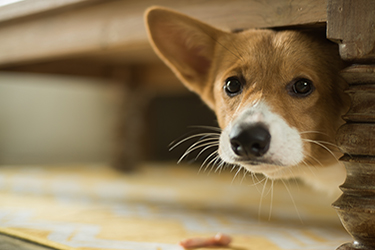Is This Bad Behavior or is it a Fear Response to Storms?

A knock at the door is often all it takes to cause a dog to bark. This type of fear response is normal as the dog is attempting to not only warn the intruder, but also to alert its people. However, sometimes sudden noises, such as those produced during a thunderstorm, will cause an animal to respond abnormally. When this happens, clients need to know that there are steps to take that will ease their pet’s fears and reduce inappropriate behaviors.
Steps to Take to Reduce a Dog’s Fear of Storms
Anxiety
Anxiety can cause fear. When an animal responds to anxiety in an immediate and excessively phobic manner, the resulting behaviors may be uncontrollable and damaging to not only the animal, but also to the surroundings. Educating clients so they understand that their animal is not behaving badly, but is reacting out of fear, will help both animal and owner.
Storm Phobia
Dogs with storm phobias may be observed exhibiting abnormal behaviors when exposed to:
- Thunder
- Lightning
- Darkness
- Wind
- Ozone changes
- Barometric changes.
Negative behaviors may be witnessed through:
- Vocalization, including:
- Intense barking
- Shrieking
- Whining
- Howling
- Pacing
- Drooling
- Trembling
- Hiding
- Freezing, refusing to move
- Refusal to follow commands
- Running away
- Hiding in small, enclosed spaces
- Causing damage as they attempt to hide in an enclosed area, for example:
- Chewing
- Scratching
- Ripping out water lines behind toilet
- Destruction to vents, hoses, cords, and/or ductwork behind washer and dryer
- Breaking out through window or door screens
- Clawing on doors or walls
- Breaking through kennel, fencing, or crate
- Injuries that occur as they attempt to escape, such as:
- Cuts on body
- Bloody pads
- Ripped or broken toenails
- Broken teeth
- Electrical shock
- Aggression.
Appropriate Methods to Handle an Animal’s Storm Phobia
When observing their animal in this fearful state, one of the first reactions of a client may be to try to soothe them, but they need to know that this method will not benefit the situation. When comforting words are uttered and the animal is pulled in for holding and petting, the soothing response sends the message to the dog that fearful behavior earns a reward, which encourages the animal to continue their behavior.
Punishing the animal won’t work either. When in a storm phobic state of mind, the animal is in a panic and not behaving out of disobedience. Punishment will only make the dog more afraid when the next storm hits.
The best steps clients can take to help their animal maintain control during a storm include:
- Distraction
- Encourage the dog with things to do that take their mind away from the fear, for instance:
- Play a favorite game
- Initiate a training session that involves treats
- Acting unconcerned, ignoring the storm
- Providing a calm environment
- For dogs that find comfort in their crate, drape the outside with a blanket
- Responding patiently, provide animal with a feeling of security without reward
- Instead of petting, apply continuous pressure to their body through:
- An arm around the dog
- Leaning on or against the dog.
Outside Dogs
Clients with outside animals may want to come up with an alternate environment if their animal has storm phobia. A metal roof makes the noise louder, and being in the kennel may make the animal feel as if the storm is fully surrounding them. A panicked animal in an outside kennel will often try to break or bite through the wire, injuring themselves as they try to escape.
Treatment Options
When an animal begins to show behaviors related to storm phobia it is important that they receive help. Clients need to know that while these behaviors will not go away, there are treatment plans that the veterinarian can initiate that will help to make their pet less fearful, making it safer for the animal and for the family as well.
The types of options include:
- Veterinary behaviorist determined treatments, including:
- Counterconditioning
- Desensitization
- Anti-anxiety devices, such as:
- Wraps
- Capes
- Eye shades
- Ear protection
- Pheromones
- Prescriptions
Clients who recognize that their pet has storm phobia can help them to respond in a less fearful and more appropriate way.
To learn more about the different approaches to better behaved pets, please contact your Covetrus representative at 855.724.3461.
Sources:http://veterinarynews.dvm360.com/noise-reactivities-and-phobias-dogs-behavior-modification-strategies?id=&sk=&date=&pageID=4
Need Regulatory Assistance
If you need help with regulatory or licensing issues, we're happy to help. We have a wide variety of resources to help you when issues arise.

Careers
Are you looking for a place to let your talents shine? At Covetrus, we help our practitioner customers better serve their patients and take pride in providing the best customer experience possible. Search our open positions to see our available opportunities.
Newsletter
Stay current with what’s going on with Covetrus, subscribe to receive our newsletter and email communications. Subscribers will receive the latest information in practice management, sales and marketing, animal health, and more.


Leave a comment